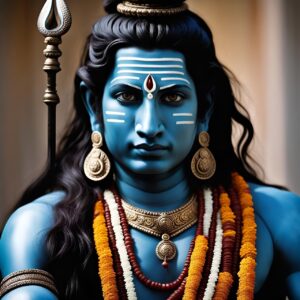In the previous article, Kularnava Tantra Part One, we started analyzing the famous tantric text, Kularnava Tantra; a major Tantric text of the Kaula school, which is written in the form of a dialogue between Shiva and Parvati.
We looked at the first five chapters as a form of inspiring guidelines that are necessary for walking the Tantric path, some of which are; the importance and the preservation of the body, the control of the senses, and the kindness of the guru. These are the bare necessities of a successful walk towards Ultimate Truth and Happiness.
In the text, Shiva also emphasizes the Adoration of Shakti and having an established practice as the main tools for the practitioner who is liberated through Kula dharma – one into which all other dharmas flow, as all the rivers into the sea.
Chapter Six
In the sixth chapter symptoms of worshippers are described, as well as the necessity of five purifications. We hear about sixteen desire-fulfilling phases of the moon originating from svaras, twelve wealth-giving kalas, mantras for purification, ten places to worship Devi, the etymology of the word Yantra, and much more.
Shiva describes the conditions for worship:
“Only Men rid of sins, devoted to meritorious actions, enriched with the knowledge of Kula, and with firm Observances should adore You.”
“Only a Sadhaka with full Consecration, Knowledge of the Essence of the Vedas, Sastras, and Devatas, and contained in his Self, should, O My Beloved! Engage himself in worship.”
“The worshiper should seat himself in a comfortable position which gives stability, and face North or East, at an isolated place or in a forest or at a place which may be free from disturbances. Pure of heart, devoid of anger and greed, superbly joyous, averse to inferior observances of ordinary men, with cheerful countenance a Sadhaka should engage himself in worship.”
It is said that any action performed against the rules does not bear fruit because it creates defects in the natural order:
“Purification of one’s own Self is said to be achieved through a good bath, purification of the elements (Bhuta-suddhi), Pranayama and Sadanga Nyasa.”
Only after such preparatory stages and observation of rules would one be pure enough to proceed to more advanced practices.
“One should meditate upon the Line of Gurus. Performing meditations thus a Sadhaka should offer incense, light, edibles, spirituous liquor, and various food-materials with Mamsa, fruit, and betel leaves.”
Chapter Seven
In the seventh chapter, Shiva describes different mantras. For example, there are mantras for 8 Kula-Shaktis and 8 non-Kula-Shaktis.
Shiva describes women who are fit for worship;
“She is called a Shakti of good characteristics who may be of a beautiful appearance, young, grave, follower of Kulacara, pious, devoid of suspicions, devoted, adherent of Sastra, free of greed, of a pleasant smile on her face, soft-spoken, devoted to Guru and Devata, of good thoughts, lover of Kaulikas, free of jealousy and envy, well-versed, interested in the worship of Devata, pleasing in personality and of good character.”
Chapter Eight
In the eighth chapter, Shiva describes seven exhilarations and their characteristics, the state of equilibrium and the practice of Shambavi Mudra, The World as the form of Shiva and Shakti, and Samadhi as the union of Shiva and Shakti.
Praudhanta Ullasa is when Sadhakas (practitioners) perform desired actions and achieve the state of ecstasy, which is a pure state described as follows:
“In this state conversation is the fruit of Japa, drowsiness is Samadhi, actions are worship, union with Shakti is Emancipation, partaking of Dravyas as if taken by Bhairava, and oration is considered as chanting Hymns of Eulogy. The contact of bodily organs is Nyasa, partaking of food is pouring of oblations in fire, Darsana is Dhyana and sleeping is like worship. In this manner, whatever actions are performed in this Ullasa they are all considered auspicious actions. Whoever considers their propriety or otherwise is a sinner. The participant Viras of such a Chakra are exalted yogis in whom men should see the form of Bhairava Himself.”
Shambavi mudra is described as the best practice of all, providing equilibrium of taste and form. The pleasure of this state can only be experienced and not described:
“Engrossed in the Supreme Bliss of Brahma-dhyana, are men of highly meritorious actions. They become bewildered and sorrowful by even a momentary interruption in this Dhyana.”
“Exhilarated by this a Vira Sadhaka is veritable Shiva.”
“Just as the waters of various streams after merging in the Ganges obtain the same quality (the quality of the Ganges water), in the same way in a Sri Chakra everyone obtains the same status.”

Chapter Nine
In the ninth chapter, Shiva describes the marks of a Yogi, 2 types of meditation, the Characteristics of Samadhi, the Characteristics of Release while living, the Characteristics of a person in Samadhi, and much more.
A Yogi controls the breath, is stable like a stone, and knows only the Supreme Self. He is immersed in Dhyana or Meditation, which is of two kinds, subtle and gross. The gross kind is a meditation upon form, while the subtle kind is one without any formal object.
Meditation promotes steadiness of Mind. One who is absorbed in Shiva alone is said to be in Samadhi. The knower of the ultimate Truth is said to be free from all Karma.
The Marks of a yogi:
“Arresting the life-breath, becoming stable like a stone and knowing only the Supreme Self and Abode is called a Yogi who knows Yoga.”
The Characteristics of Samadhi:
“The condition of Dhyana where there is no awareness, which may be like a calm sea, where there is an absence of Form, that Dhyana is called Samadhi.”
The Characteristics of Release while Living:
“When the Reality shines forth by itself and not by any mental thinking; and when such a Reality shines forth on its own one should immediately become engrossed in it.
One who appears as if asleep whether in dreaming or in the waking states, who neither inhales nor exhales and becomes immobile, he is truly Freed.”
Yoga is the union of Jivatma (soul) and the Atma (supreme Self). There is no difference between Jivatma and Paramatma:
“Just as no differences exist when water is thrown into water, milk in mik, Ghee into Ghee, similarly there remains no difference between the Jivatma and Paramatma.”
Characteristics of Superior Kaulika are described in the following way:
“Away from misery, content, devoid of dualities, free of jealousy, without insolence, anger, show, desire and ego, truthful in speech, not enslaved to the senses, masters of the Kula Path are not fickle.”
It is said that the teacher of the Kula-dharma is rare in the World. He reaches this status only by a happy ripening of the previous merits, not otherwise. Wherever the knower of Kula lives, that place is sanctified. By his mere sight and by his worship thrice seven generations are uplifted. A natural joy is obtained by the one engrossed in the pursuit of Knowledge of Truth. Such a wise person leaves all volitions and all actions, referring to the well-known fact that Tantrics live in the world but are not of the world. This is the supreme asceticism:
“The Yogi who maintains his equilibrium in censure and praise, in cold and warmth, in pleasure and pain, among friends and foes, he is the master Yogi devoid of either exuberance or depression.”
Shiva continues revealing to Parvati, that one who worships Her, should worship Her devotees too, and in this way find his grace. In this sacred text, it is clear that whoever adheres to laws or enters Kuladharma without knowing its ways, is a sinner and his house is like a burial ground:
“Disregarding the Knower of Kula, whatever one gives, donates or sacrifices, or however he may do penances, worship or Japa, all that is useless.”
Chapter Ten
In the tenth chapter, Shiva describes Three kinds of worship as well as their Occasions, Characteristics of Sri Chakra, and much more.
Daily worship is considered the best; worship on special occasions is in the middle, and monthly worship is the lowest.
If a Sadhaka spends more than a month without worship he becomes a Pasu (or ordinary man).
The best days for worship are the birthday of a Guru, one’s own birthday, and the day of changing zodiac sign.
Shakti should be worshipped on Friday since she is in connection with the energies of Venus and therefore the energies of Love.
There are mentioned Methods of Shakti worship on Fridays by inviting beautiful willing ladies bearing all auspicious signs and blooming in youth. One should purify her body with a good bath, seat her properly, and embellish her with fragrance, flowers, and beautiful clothes. Thereafter one can invoke the Deity in the lady, worship her with incense, and satisfy her with Mamsa.
Chapter Eleven
In the eleventh chapter, the Time of worship is described, the Duties of a Sadhaka are described, Five actions and five sins prohibited for Kaulikasm are given, and much more.
Daily worship should be performed in the daytime and occasional worships should be performed during the night.
Some things are described that should be venerated when seen; Raw Flesh, Sura or wine, Kumbha or pot, Asoka tree, virgins engaged in play, cremation-ground, a group of ladies, a red-robed lady.
All women should be treated as Mothers, and all women should be worshiped:
“Whatever ladies are there in the world, they all should be treated as mothers. Outraging the modesty of a woman angers the Yoginis. If a lady commits a hundred crimes she should not yet be struck by even a flower. The faults of a lady should never be counted and their qualities should always be publicized.”
The speciality of Kaulas are said to be 1. Nigraha or Restraint and 2. Anugraha or Kindness;
“Essence of Shaivism is Knowledge of Truth, of Garudavidya capacity to take poison, of Astrology the capacity to predict about Eclipses and of Kaula Restraint and Kindness.”
Tantric scripture again and again emphasizes the importance of sacrifice and ardent practice, That is why it is said that “A gram of practice is worth a ton of theory.”
“Just as Agni (Fire) purifies impurities of gold, in the same way, one should burn all the impurities of his bad conduct in the fire of Penance.”
Even with goodwill and all the advice of the Guru, one needs perseverance and the discipline of adhering to rules, to reach spiritual heights.
“Guru gives advice on how to behave or Acara at least three times, after which if the disciple does not adhere to rules, Guru leaves him.”
This article was written by Zita Jerkovic.
To be continued….

